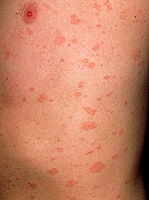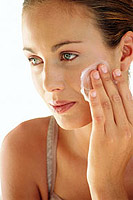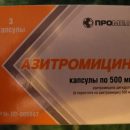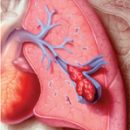Symptoms of pink linga. Diagnosis and treatment of pink deprivation. You can read more in the article.
Content
Pink deprived (ZIBER's disease) — This is a common skin disease, a characteristic feature of which fusking pink spots are. Meets at any age, but more often in young people. The reason for the occurrence of pink deprivation unknown — The viral nature of the disease is supposed. Pink deprived often develops on a cold background, more often in spring or autumn. In people with a weakened immunity, a disease may re-occur.
Symptoms of pink linga
 The disease begins with the appearance on the skin of a single major rounded spot of pink color with a diameter of 2 cm and more (the so-called maternal plaque), the central part of which gradually acquires a yellowish tint, and begins to peel.
The disease begins with the appearance on the skin of a single major rounded spot of pink color with a diameter of 2 cm and more (the so-called maternal plaque), the central part of which gradually acquires a yellowish tint, and begins to peel.
Usually 7-10 days after the appearance of the first spots on the skin, multiple oval pink stains with a diameter of 0.5-1 cm occur. The most abundant rash on the side surfaces of the body, back, shoulders. For rash is characterized by peeling in the center of spots, and on the periphery — Free from scales Red border, why stains acquire resemblance to medallions. Separate spots do not merge among themselves.
Typically patients are bothering only a small itch. The duration of the disease is 4-6 weeks, after which the rashes spontaneously disappear.
With incorrect treatment — Frequent washing, use of irritating means of means (ointments containing sulfur, tar and t.D.), as well as with increased sweating and in persons with allergic reactions, rashes can remain much longer.
Diagnosis and treatment of pink deprivation
The diagnosis is established dermatologist In case of inspection, no other studies are required.
As a rule, the disease passes independently, without treatment. The patient is not recommended to take a bath (you can wash, but use soft detergents for this). Independently apply ointments and pastes should not, it can lead to even greater spread. During the disease, it is not recommended to stay in the sun. It is prohibited to carry synthetic clothes.
With a strong itching, antiallergic and anti-inflammatory creams and ointments are prescribed, or a bolt (for example, cydol).
In rare cases, in patients with reduced immunity or in case of improper treatment, a complicated course of the disease is possible with an increase in temperature. At the same time, the doctor can be additionally appointed antibiotics.









